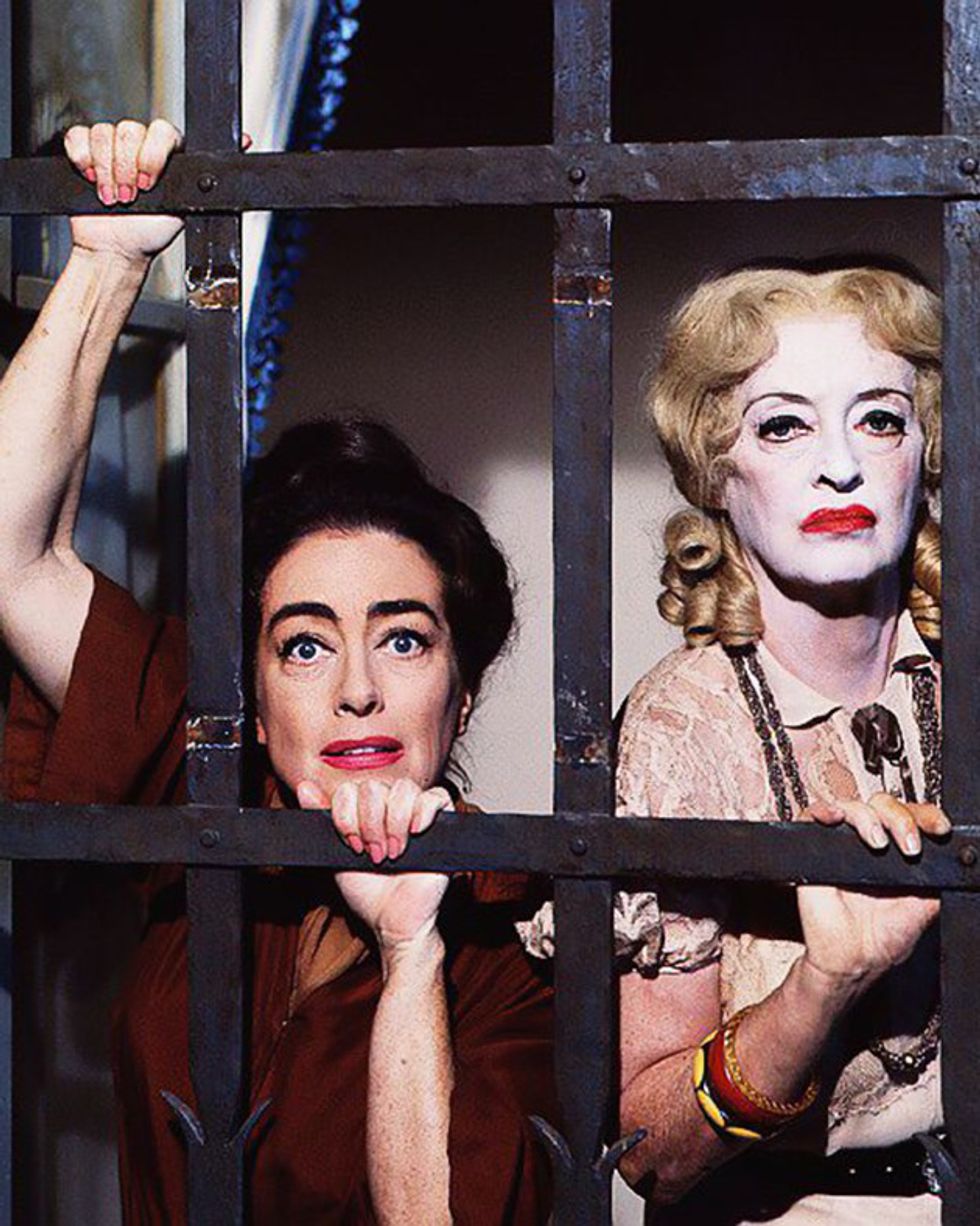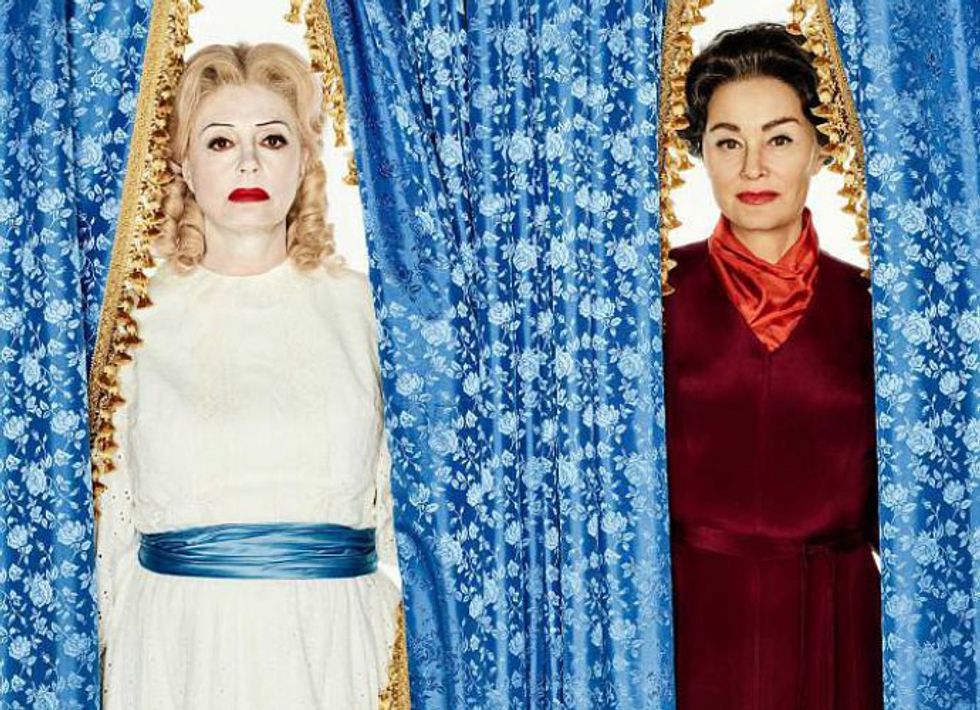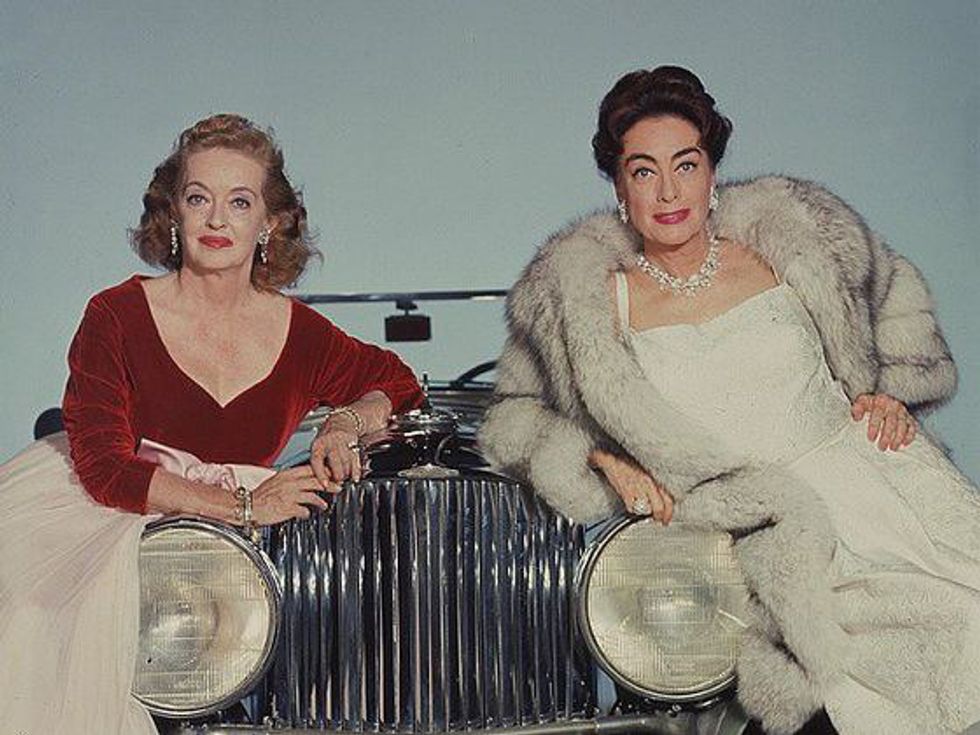It was while watching "Whatever Happened to Baby Jane?" with a friend the other day that I found myself having trouble explaining the duality of its status. It is a quality film inextricably linked to a legacy that undermines its seriousness. To be sure, it is an amazing movie from start to finish, full of clever camera techniques and, of course, Bette Davis and Joan Crawford, who by that point in their careers knew how to command the camera. But to most modern day viewers, unfamiliar to the legacies and acting styles of the two women, the full grotesque effect of Bette Davis' shrieking harridan holds little to no artistic merit while Joan Crawford's nuanced performance, when compared to Davis' lack of abandon, seems flat and dull. Still, watch closely and you'll see two pros and near lifelong rivals waging two simultaneous wars: as onscreen sisters fighting for survival, and as aging stars desperate for the one movie that can kickstart their career.
The real Davis and Crawford
The lives and characters of Davis and Crawford are enshrined in the cultural lexicon not as iron-willed actresses who fought a larger-than-God studio system to claim parts they wanted and deserved, but as jokes. "Mommie Dearest" derailed any chance of a positive legacy for Joan Crawford, while nearly every modern portrayal of Davis is parodic, with emphasis on her cigarettes, voice, and walk. Ryan Murphy's latest limited series, "Feud: Bette and Joan," is the latest and greatest in his star-studded line of anthological series. The eight episode season follows the making of the 1962 classic "Whatever Happened to Baby Jane?," and finds Davis (played by Susan Sarandon) and Crawford (Jessica Lange) pitted against and forced to work with one another during low points in their lives and careers. Superb writing, fantastic acting, fascinating subject matter, and production value all coalesce, creating a show not content to simply write off the two legends as the monsters they've come to be seen as, but as real women who lived and felt and fought.
Sarandon as Davis with Lange as Crawford
I mention their legacy because, while the first episode offers slightly forced exposition in their backgrounds (the 1978 interviews with Catherine Zeta-Jones' Olivia de Havilland and Kathy Bates' Joan Blondell, while entertaining, seemed unnecessary), and its focus is on the difficulty older women in Hollywood have obtaining decent roles (in one scene, Crawford turns down playing Elvis' grandmother - a slap in the face to the Academy Award winner), it carries the Herculean task of giving the public something vital and relevant from two women who hit their professional peak seventy years ago. Murphy could have made the choice to play into the long-established stereotypes, but instead he (and Lange and Sarandon) offer raw, genuine introspection into these icons. The sight of Crawford lounging around her house almost seems like sacrilege (she famously insisted on staying camera ready at all times) and the visible loneliness that Davis feels is contradictory to her persona of independence and that time-honored New England patrician inner strength. That isn't to say that these women are unrecognizable; the plastic slipcovers on her living room furniture are a light jab at Joan's well-documented germophobia, while Davis reaches for a cigarette before opening her eyes in the morning. But this show, unlike other representations of Crawford and Davis, goes beyond "chainsmoker" and "neat freak." The women depicted in this show are real.
The scenery, meticulously made to look like the early 1960s, is spacious enough to grant each of the leads a chance to seem dwarfed in comparison, isolated in a sea of pseudo-sycophants. This same scenery drives an aesthetic wedge between the two. Crawford prefers icy blues, sterile whites, and her home can best be described as "postmodern antiseptic," while Davis' home is full of warm, inviting earth tones. Something so ostensibly innocuous as the decorations in a woman's home only adds fuel to the fire: here are two entirely different women (though similar in many, many respects) facing oblivion with one final chance to shine, and their major differences are comprised of such inconsequential details as their choice of liquor (Crawford never strays from vodka, Davis prefers Scotch) and upholstery.
Ageism is the show's primary target. It displays two Oscar winning actresses with real talent who desperately want to work, yet are - in their 50s - deemed too old for decent roles by the same men who made them stars. This tale as old as time could have been written about any two actresses, but only Crawford and Davis were audacious and talented enough to make a fifty year old rivalry-cum-footnote in history must-see TV.
"Feud: Bette and Joan" airs Sundays at 10 PM on FX.





















